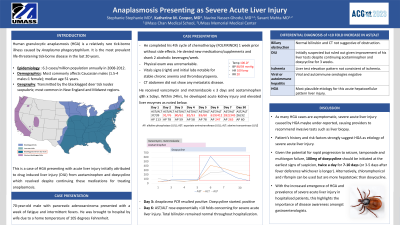Tuesday Poster Session
Category: Liver
P3873 - Anaplasmosis Presenting as Acute Liver Injury
Tuesday, October 24, 2023
10:30 AM - 4:00 PM PT
Location: Exhibit Hall

Has Audio

Katherine M. Cooper, MD
UMass Chan Medical School
Worcester, MA
Presenting Author(s)
Stephanie Stephanie, MD1, Katherine Cooper, MD1, Navine Nasser-Ghodsi, MD2, Savant Mehta, MBBS, MD, DM3
1University of Massachusetts Medical Center, Worcester, MA; 2UMass Chan Medical School, Worcester, MA; 3UMass Memorial Healthcare, Worcester, MA
Introduction: Human granulocytic anaplasmosis (HGA) is a rare tick-borne illness caused by Anaplasma phagocytophilum. It has become the most prevalent life-threatening tick-borne disease in the last 20 years. Most reported cases in the U.S. are from the New England and Midwest regions. The disease affects mostly Caucasian males with a median age of 51 years. As many HGA cases are asymptomatic, there is significant under-reporting. The lack of clinician awareness further exacerbates the gaps in knowledge regarding this disease. In the correct epidemiologic setting, HGA should be considered in patients presenting with acute liver injury.
Case Description/Methods: A 70-year-old male with pancreatic adenocarcinoma presents with fatigue and intermittent fevers after he completed his fourth cycle of chemotherapy a week ago. On admission he was hypotensive (88/59 mmHg), tachycardic (109 bpm) and had a 100.2F temperature. Initial labs showed chronic anemia and thrombocytopenia. Otherwise, CT scan, blood culture and physical exam were benign. He denied any new medications, supplements or drugs. He drinks two alcoholic drinks a week. Due to concerns of sepsis, he got piperacillin-tazobactam and vancomycin empirically, and acetaminophen 500mg every eight hours for 3 days. Within 24 hours he developed acute kidney injury, elevated alkaline phosphatase 113U/L and AST/ALT 80/62U/L. He later disclosed that he owned a construction company and recalled a tick bite a week prior to presentation. Work-up showed no evidence of Lyme, ehrlichiosis, babesia or leptospirosis, but a positive anaplasma PCR on day 3. His antibiotics were switched to doxycycline 100mg every 12 hours. On day 6, AST/ALT rose exponentially to 619/412 U/L, AP 265 U/L, lipase 127 U/L, and plateaued. Bilirubin remained normal.
Discussion: Differentials of elevated transaminase >10 folds UNL include biliary obstruction, drug induced liver injury (DILI), ischemia, viral or autoimmune hepatitis. There was no evidence of biliary obstruction on imaging or cholangitis with a normal bilirubin. Viral panel was negative. DILI from acetaminophen and doxycycline was initially suspected but quickly dismissed given no worsening hepatic function despite continuing doxycycline. Thus, HGA was the most plausible etiology for this acute hepatocellular injury. The lack of documented relationship between severe acute liver injury caused by HGA may cause unnecessary invasive testing like liver biopsy. This highlights the importance of disease awareness amongst gastroenterologists.
Disclosures:
Stephanie Stephanie, MD1, Katherine Cooper, MD1, Navine Nasser-Ghodsi, MD2, Savant Mehta, MBBS, MD, DM3. P3873 - Anaplasmosis Presenting as Acute Liver Injury, ACG 2023 Annual Scientific Meeting Abstracts. Vancouver, BC, Canada: American College of Gastroenterology.
1University of Massachusetts Medical Center, Worcester, MA; 2UMass Chan Medical School, Worcester, MA; 3UMass Memorial Healthcare, Worcester, MA
Introduction: Human granulocytic anaplasmosis (HGA) is a rare tick-borne illness caused by Anaplasma phagocytophilum. It has become the most prevalent life-threatening tick-borne disease in the last 20 years. Most reported cases in the U.S. are from the New England and Midwest regions. The disease affects mostly Caucasian males with a median age of 51 years. As many HGA cases are asymptomatic, there is significant under-reporting. The lack of clinician awareness further exacerbates the gaps in knowledge regarding this disease. In the correct epidemiologic setting, HGA should be considered in patients presenting with acute liver injury.
Case Description/Methods: A 70-year-old male with pancreatic adenocarcinoma presents with fatigue and intermittent fevers after he completed his fourth cycle of chemotherapy a week ago. On admission he was hypotensive (88/59 mmHg), tachycardic (109 bpm) and had a 100.2F temperature. Initial labs showed chronic anemia and thrombocytopenia. Otherwise, CT scan, blood culture and physical exam were benign. He denied any new medications, supplements or drugs. He drinks two alcoholic drinks a week. Due to concerns of sepsis, he got piperacillin-tazobactam and vancomycin empirically, and acetaminophen 500mg every eight hours for 3 days. Within 24 hours he developed acute kidney injury, elevated alkaline phosphatase 113U/L and AST/ALT 80/62U/L. He later disclosed that he owned a construction company and recalled a tick bite a week prior to presentation. Work-up showed no evidence of Lyme, ehrlichiosis, babesia or leptospirosis, but a positive anaplasma PCR on day 3. His antibiotics were switched to doxycycline 100mg every 12 hours. On day 6, AST/ALT rose exponentially to 619/412 U/L, AP 265 U/L, lipase 127 U/L, and plateaued. Bilirubin remained normal.
Discussion: Differentials of elevated transaminase >10 folds UNL include biliary obstruction, drug induced liver injury (DILI), ischemia, viral or autoimmune hepatitis. There was no evidence of biliary obstruction on imaging or cholangitis with a normal bilirubin. Viral panel was negative. DILI from acetaminophen and doxycycline was initially suspected but quickly dismissed given no worsening hepatic function despite continuing doxycycline. Thus, HGA was the most plausible etiology for this acute hepatocellular injury. The lack of documented relationship between severe acute liver injury caused by HGA may cause unnecessary invasive testing like liver biopsy. This highlights the importance of disease awareness amongst gastroenterologists.
Disclosures:
Stephanie Stephanie indicated no relevant financial relationships.
Katherine Cooper indicated no relevant financial relationships.
Navine Nasser-Ghodsi indicated no relevant financial relationships.
Savant Mehta indicated no relevant financial relationships.
Stephanie Stephanie, MD1, Katherine Cooper, MD1, Navine Nasser-Ghodsi, MD2, Savant Mehta, MBBS, MD, DM3. P3873 - Anaplasmosis Presenting as Acute Liver Injury, ACG 2023 Annual Scientific Meeting Abstracts. Vancouver, BC, Canada: American College of Gastroenterology.
